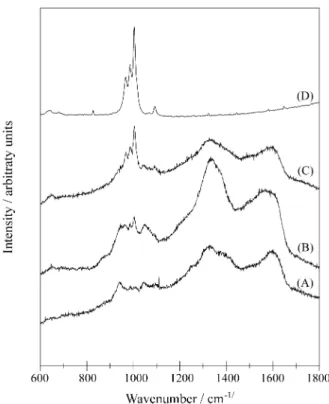Formation of a Novel Polypyrrole/Porous
Phosphate Glass Ceramic Nanocomposite
Iara F. Gimenez, and Oswaldo L. Alves
Laboratório de Química do Estado Sólido, Instituto de Química, UNICAMP,
C.P. 6154, 13083-970 Campinas - SP, Brazil
Este trabalho focaliza a obtenção de um novo nanocompósito, formado mediante a polimeri-zação in situ de monômeros de pirrol na superfície dos poros de vitrocerâmicas porosas com esqueleto LiTi2(PO4)3, após troca-iônica com cobre.
This work is concerned with evidences of a new composite system, formed by in situ
polimerization of pyrrole moieties in the copper-exchanged pore surface of LiTi2(PO4)3 glass
ceramic.
Keywords: polypyrrole, porous glass-ceramics, nanocomposites
Introduction
Many aspects can justify efforts towards the preparation of conducting polymers within bulk matrices. When the host material has nanometric pores, occurence of cross-linking during the polimerization can be minimized by simple physical constraints, and as a consequence the elec-trical conductivity can be increased or decreased depending on the type of used matrix1. For instance, preparation of linear polypyrrole chains inside the pore structure of Porous Vycor Glass has been described by Alves and co-workers2-4. Alternatively, interest can arise when the porous host ex-hibits ionic conductive properties, such as the well known Nasicon-type solids5. In this context, this work reports the preparation of polypyrrole inside the pores of Nasicon-type LiTi2(PO4)3 glass-ceramics6.
Experimental
Original glass samples of nominal composition 6Li2O.24TiO2.39CaO.31P2O5 were prepared by melting reagent grade Li2CO3, CaCO3, TiO2 (anatase) and P2O5 in platinum crucibles at 1350 °C for 1 h in air. The melts were poured onto carbon plates and annealed at 630 °C for 1 h. Glass-ceramic samples were prepared by the thermal treat-ment of the glasses at 630 °C for 24 h and subsequently at 720 °C for 12 h. Immersion of glass-ceramic plates in 1 Mol/L HCl aqueous solutions, at room temperature for 24 h, allows the formation of a continuous porous network. Exchange of Li+ and H+ ions originally present in the pore surfaces by Cu2+ ions was performed by immersion of the
glass-ceramic plates in 1 Mol/L Cu(CH3COO)2 aqueous solutions, at room temperature for 24 h.
Composite preparation was performed by heating the glass-ceramic samples in the excess of freshly distilled pyrrole, at the boiling temperature of the liquid during 1 h. Raman spectra were recorded using a Renishaw Raman Imaging Microscope System 3000, using the 632.8 nm line of a He-Ne laser. Electron Scanning Micrographs were recorded using a MEV JEOL JSM T-300 Microscope.
Results and Discussion
According to TGA measurements, the amount of poly-mer present in the nanocomposite samples was found to be around 3.5% in weight. Figure 1 shows the photomicro-graphs of the glass-ceramic samples in (A) and of the nanocomposite samples in (B). The glass-ceramics exhibits fine-grained microstructures, with numerous voids present along the surface. After the growth of polypyrrole, a rough texture covering the ceramic surface can be observed.
The Fig. 2 shows Raman spectra obtained from differ-ent points on the surface of the same sample. A typical spectra of the original glass-ceramic can be observed in (D), showing only orthophosphate bands related to the LiTi2(PO4)3 phase 5, centered at 1003, 986 and 966 cm-1. The spectra shown in (B) and (C) both reveal the coexis-tence of typical polypyrrole and phosphate bands. The spectrum shown in (A), however, is dominated by polypyr-role bands. Concerning the conductive polymeric phase, more than provide evidences of polymerization, the vibra-tional spectroscopies can be used to get information about Note
e-mail: gimenez@iqm.unicamp.br and oalves@iqm.unicamp.br
J. Braz. Chem. Soc., Vol. 10, No. 2, 167-168, 1999. © 1999 Soc. Bras. Química
the degree of oxidation of conducting polymers7.In (A), the bands at 1594 cm-1 and 1360 cm-1 can be associated to the presence of polypyrrole in partially dopped states. In the neutral form of polypyrrole, the last band is most likely to occur above 1610 cm-1. Additionally, the bands observed near 943 cm-1 and 1048 cm-1 can be assigned to the struc-tures responsible for charge transport through the chains, namely bipolarons and polarons7. Finally, the Raman spec-tra in Fig. 2 are in good agreement with those reported by Alves and co-workers2-4, for polypyrrole present in the pores of Porous Vycor Glass.
In summary, preliminary data reported here allows us to conclude that the porous copper (II) exchanged LiTi2(PO4)3 glass-ceramics is a suitable host for obtaining stable nanocomposites through its interaction with
polypir-rol. Studies related with the electrical conductivity and redox properties are in progress in our laboratory.
Acknowledgments
The authors are gratefull to CNPq, Fapesp and PRONEX-MCT for the financial support.
References
1. Ruiz-Hitzky, E.; Aranda, P. An. Quim. Int. Ed.1997,
93, 197.
2. Maia, D.J.; Zarbin, A.J.G.; Alves, O.L.; De Paoli, M-A. Adv. Mater.1995, 7, 792.
3. Zarbin, A.J.G.; De Paoli, M-A.; Alves, O.L. Synth. Met. 1997, 84, 107.
4. Zarbin, A.J.G.; De Paoli, M-A.; Alves, O.L. Synth. Met. 1999, 99, 227.
5. Tarte, P.; Rulmont, A.; Merckaert-Ansay, C. Spectro-chim. Acta 1986, 42A, 1009.
6. Hosono, H.; Zhang, Z.; Abe,Y. J. Am Ceram. Soc. 1989, 72, 1587.
7. Furukawa, Y.; Tazawa, S.; Fujii, Y.; Harada, I. Synth. Met.1988, 24, 329.
Received: December 11, 1998
FAPESP helped in meeting the publication costs of this article
168 Gimenez & Alves J. Braz. Chem. Soc.
Figure 2. Raman spectra of: (A), (B) and (C): different points on the surface of a nanocomposite sample; (D): original porous glass-ceramic sample.
